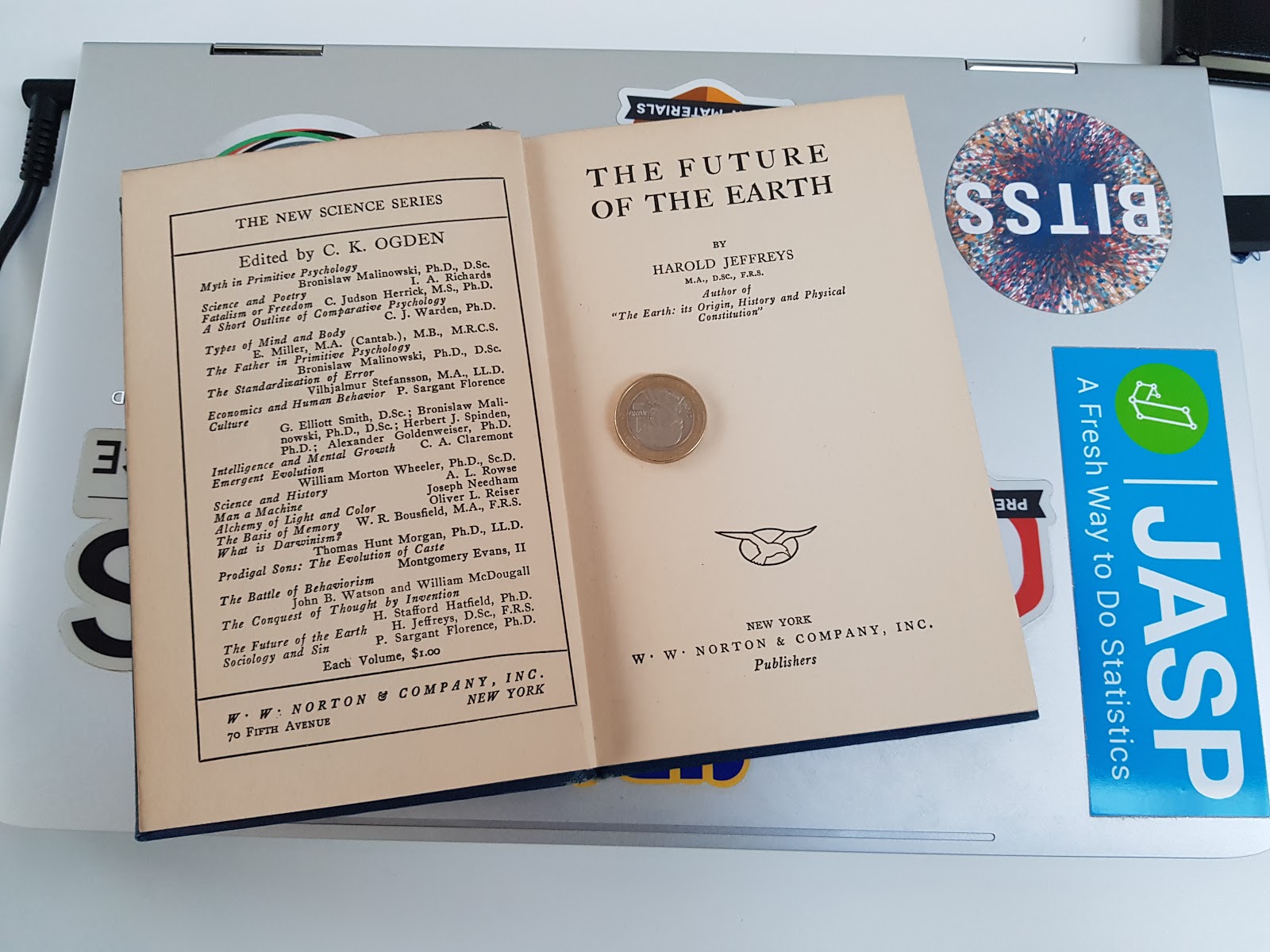Most statisticians know Sir Harold Jeffreys as the conceptual father and tireless promotor of the Bayesian hypothesis test. However, Jeffreys was also a prominent geophysicist. For instance, Jeffreys is credited with the discovery that the earth has a liquid core. Recently, I read Jeffreys’s 1929 book “The Future of the Earth”, which is a smaller and more accessible version of his major work “The Earth” (Jeffreys, 1924). Indeed, the book is literally “small”. Below is a photo meant to convey the book’s size:
The book’s contents is organized along three short chapters covering topics of fundamental importance:
- The Future of the Sun
- The Cooling of the Earth
- The Future of the Moon
In 79 pages, “The Future of the Earth” offers an accessible treatise on once-current theories concerning the sun, the earth, and the moon. For instance, the book discusses the Jeans & Jeffreys “tidal theory” of the original of the earth (I have not discussed this with a geophysicist or astronomer, but at the very least the theory still seems to be taught at universities). The book also deals with George Darwin’s theory of the origin of the moon, a theory that has now been abandoned. Overall, the book is intellectually inspiring, and, in contrast to most of Jeffreys’s other work, it is reasonably easy to follow. Short, clearly written books that explain key scientific theories of fundamental importance: I wish there were more of those, and I wish Jeffreys had written one on statistical inference.
Before continuing, the epigraph needs to be mentioned:
“From the Prose Edda of Snorri Sturluson (13th century) founded on the Elder Edda: Gylfaginning ch. 51.
Then that happens which is thought a great event, that the wolf swallows the sun, and men deem that sore damage; then the second wolf takes the moon, and he also does a very ill turn; the stars fall from heaven.”
At the end of the book, Jeffreys summarizes its contents as follows:
“We have started from the time when the earth was formed as a gaseous mass from a filament torn out of the sun by a passing star; we have sketched how the moon was formed, and how tidal friction and changes in internal temperature have affected the development of the earth and moon up to the present time. Looking into the future, we have traced the moon out to its maximum distance from the earth and back to its ultimate destruction when it again gets too near the earth’s surface. We have seen how one mountain system after another will be formed on the earth and worn down; and we have seen how mountain systems will be formed on the moon and not worn down. Finally we have seen how, in about a billion years from now, the sun will have declined in activity sufficiently for the ocean to freeze at the equator, and how, in a much longer time, the earth’s surface will have cooled to the temperature of liquid helium. The result is not very different from that described by our Icelandic ancestors in the legend quoted at the beginning of this work.” (Jeffreys, 1929, pp. 78-79).
Some of this work has of course been overtaken by advance; for instance, my current understanding is that the sun will at some point in the future expand to swallow the earth, so that, instead of the oceans at the equator freezing, they will instead evaporate (or maybe they will first freeze, and then evaporate?). But those are just details of course. This is a marvellous book, and if I were a geophysicist I would make it mandatory reading for new students (with the assignment to interpret Jeffreys’s reasoning in light of our current knowledge).
Finally, to illustrate the playful nature of the book, here is the Great Discover on the Earth’s Core:
“Since iron is the commonest heavy metal at the surface we are led to suppose that the central core is made of iron in a liquid state. There is therefore strong evidence of such internal temperatures as confirm the supposition that the earth was once liquid as a whole. Incidentally such a heated core has an obvious theological application, particularly as some geophysicists have supposed it to be surrounded by a zone of sulphides.”’ (Jeffreys, 1929, pp. 35-36)
References
Jeffreys, H. (1924). The earth: Its origin, history and physical constitution. Cambridge: Cambridge University Press.
Jeffreys, H. (1929). The future of the earth. New York: Norton.
About The Authors

Eric-Jan Wagenmakers
Eric-Jan (EJ) Wagenmakers is professor at the Psychological Methods Group at the University of Amsterdam.




